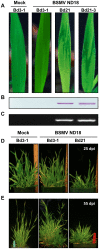Fine mapping of the Bsr1 barley stripe mosaic virus resistance gene in the model grass Brachypodium distachyon
- PMID: 22675544
- PMCID: PMC3366947
- DOI: 10.1371/journal.pone.0038333
Fine mapping of the Bsr1 barley stripe mosaic virus resistance gene in the model grass Brachypodium distachyon
Abstract
The ND18 strain of Barley stripe mosaic virus (BSMV) infects several lines of Brachypodium distachyon, a recently developed model system for genomics research in cereals. Among the inbred lines tested, Bd3-1 is highly resistant at 20 to 25 °C, whereas Bd21 is susceptible and infection results in an intense mosaic phenotype accompanied by high levels of replicating virus. We generated an F(6:7) recombinant inbred line (RIL) population from a cross between Bd3-1 and Bd21 and used the RILs, and an F(2) population of a second Bd21 × Bd3-1 cross to evaluate the inheritance of resistance. The results indicate that resistance segregates as expected for a single dominant gene, which we have designated Barley stripe mosaic virus resistance 1 (Bsr1). We constructed a genetic linkage map of the RIL population using SNP markers to map this gene to within 705 Kb of the distal end of the top of chromosome 3. Additional CAPS and Indel markers were used to fine map Bsr1 to a 23 Kb interval containing five putative genes. Our study demonstrates the power of using RILs to rapidly map the genetic determinants of BSMV resistance in Brachypodium. Moreover, the RILs and their associated genetic map, when combined with the complete genomic sequence of Brachypodium, provide new resources for genetic analyses of many other traits.
Conflict of interest statement
Figures



References
-
- Jackson AO, Hunter BG, Gustafson GD. Hordeivirus Relationships and Genome Organization. Annual Review of Phytopathology. 1989;27:95–121.
-
- Carroll TW. Hordeiviruses: Biology and Pathology. In: Regenmortel MHVv, Fraenkel-Conrat H., editors. The Plant Viruses, The Rod-shaped Plant Viruses. New York: Plenum Press; 1986. pp. 373–395.
-
- Jackson AO, Lane LC. Hordeiviruses. In: Kurstak E, editor. Handbook of Plant Virus Infections and Comparative Diagnosis. Amsterdam: Elsevier/North-Holland, Amsterdam; 1981. pp. 565–625.
-
- Jackson AO, Lim H-S, Bragg J, Ganesan U, Lee MY. Hordeivirus Replication, Movement, and Pathogenesis. Annual Review of Phytopathology. 2009;47:385–422. - PubMed
-
- McKinney HH, Greeley LW. Washington: U.S. Dept. of Agriculture; 1965. Biological characteristics of barley stripe-mosaic virus strains and their evolution.
Publication types
MeSH terms
Substances
LinkOut - more resources
Full Text Sources
Other Literature Sources
Miscellaneous

